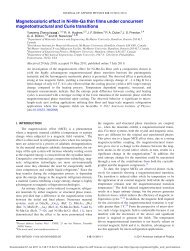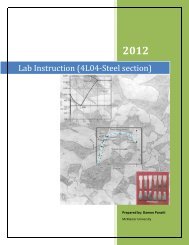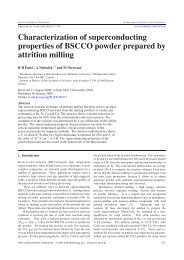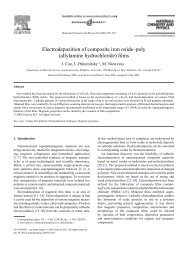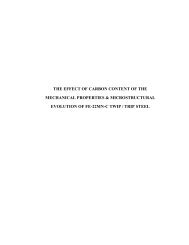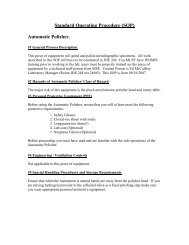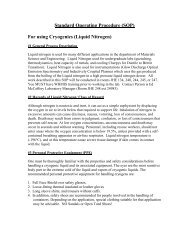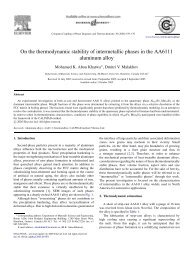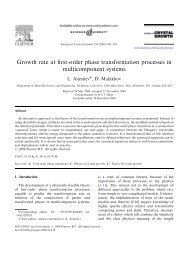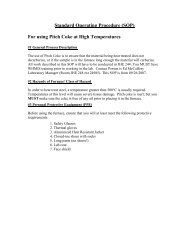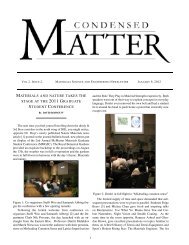E407-07 Microetching Metals and Alloys.pdf - McMaster Department ...
E407-07 Microetching Metals and Alloys.pdf - McMaster Department ...
E407-07 Microetching Metals and Alloys.pdf - McMaster Department ...
You also want an ePaper? Increase the reach of your titles
YUMPU automatically turns print PDFs into web optimized ePapers that Google loves.
TABLE 2 Continued<br />
Etchant Composition Procedure<br />
72 10 mL HF<br />
45 mL HNO 3<br />
45 mL water<br />
Swab for 5–20 s.<br />
73 20 mL HCl Electrolytic etch—use carbon cathode <strong>and</strong> platinum wire connection to specimen.<br />
25 g NaCl (a) 6 V ac for 1 min.<br />
65 mL water (b) 5 V–20 V ac for 1–2 min.<br />
(c) 20 V ac for 1–2 min.<br />
For etch-polishing, use shorter times. After etching, water rinse, alcohol rinse, <strong>and</strong> dry.<br />
74 1–5 mL HNO 3 Etching rate is increased, sensitivity decreased with increased percentage of HNO 3.<br />
100 mL ethanol (95 %) or methanol (95 %) (a) Immerse few seconds to a minute.<br />
(b) Immerse 5–40 s in 5 % HNO 3 solution. To remove stain, immerse 25 s in 10 % HClmethanol<br />
solution.<br />
(c) For Inconels <strong>and</strong> Nimonics, use 5 mL HNO 3 solution—electrolytic at 5–10 V for 5–20 s.<br />
(d) Swab or immerse several minutes.<br />
(e) Swab 5–60 s. HNO 3 may be increased to 30 mL in methanol only depending on alloy.<br />
(Ethanol is unstable with over 5 % HNO 3.) Do not store.<br />
75 5 g picric acid<br />
8 g CuCl 2<br />
20 mL HCl<br />
200 mL ethanol (95 %) or methanol (95 %)<br />
Immerse 1–2 s at a time <strong>and</strong> immediately rinse with methanol. Repeat as often as necessary.<br />
(Long immersion times will result in copper deposition on surface.)<br />
76 4 g picric acid<br />
Composition given will saturate with picric acid. Immerse few seconds to a minute or more.<br />
100 mL ethanol (95 %) or methanol (95 %) Adding a wetting agent such as zepherin chloride will increase response.<br />
77 10 g picric acid<br />
Composition given will saturate the solution with picric acid. Immerse few seconds to a<br />
5 drops HCl<br />
100 mL ethanol (95 %) or methanol (95 %)<br />
minute or more.<br />
78 10 g potassium metabisulfite<br />
100 mL water<br />
Immerse 1–15 s. Better results are sometimes obtained by first etching lightly with No. 76<br />
or 74.<br />
79 40 mL HCl<br />
5 g CuCl2 30 mL water<br />
25 mL ethanol (95 %) or methanol (95 %)<br />
Swab few seconds to a minute.<br />
80 5 mL HCl<br />
Immerse or swab few seconds to 15 min. Reaction may be accelerated by adding a few<br />
1 g picric acid<br />
100 mL ethanol (95 %) or methanol (95 %)<br />
drops of 3 % H2 O2. Optional (for prior austenite grain boundaries)—temper specimen at<br />
600–900°F prior to preparation.<br />
81 2 g picric acid Composition given will saturate the solution with picric acid.<br />
1 g sodium tridecylbenzene sulfonate. (a) Immerse few seconds to a minute.<br />
100 mL water (b) Immerse to 15 min with occasional swabbing for heavy grain boundary attack.<br />
82 5 g FeCl 3<br />
5 drops HCl<br />
100 mL water<br />
83 10 g CrO 3<br />
100 mL water<br />
84 10 mL H 2 SO 4<br />
10 mL HNO 3<br />
80 mL water<br />
85 2 g picric acid<br />
25 g NaOH<br />
100 mL water<br />
86 3 g oxalic acid<br />
4mLH 2 O 2 (30 %)<br />
100 mL water<br />
87 10 mL HNO 3<br />
20–50 mL HCl<br />
30 mL glycerol<br />
88 10 mL HNO 3<br />
20 mL HCl<br />
30 mL water<br />
<strong>E4<strong>07</strong></strong> − <strong>07</strong> ´1<br />
Copyright by ASTM Int'l (all rights reserved); Thu Sep 20 10:14:59 EDT 2012<br />
13<br />
Downloaded/printed by<br />
MC MASTER UNIVERSITY pursuant to License Agreement. No further reproductions authorized.<br />
Immerse 5–10 s.<br />
Use a certified <strong>and</strong> tested hood—(a) Electrolytic at 6 V for 5–60 s. Attacks carbides.<br />
(b) Electrolytic at 6 V for 3–5 s.<br />
Use a certified <strong>and</strong> tested hood. Precaution—Add H 2 SO 4 slowly to water <strong>and</strong> cool, then<br />
add HNO 3. Immerse 30 s. Swab in running water. Repeat three times <strong>and</strong> repolish lightly.<br />
Use a certified <strong>and</strong> tested hood. Immerse in boiling solution for 5 min. Precaution—Do not<br />
boil dry—anhydrous picric acid is unstable <strong>and</strong> highly explosive. Alternative: Electrolytic at<br />
6 V for 40 s (room temperature). Use stainless steel cathode.<br />
Use a certified <strong>and</strong> tested hood. Solution should be freshly prepared. Immerse 15–25 min<br />
when specimens or parts cannot be given usual metallographic polish. Multiple etching<br />
may be required.<br />
Use a certified <strong>and</strong> tested hood—Can give off nitrogen dioxide gas. Precaution—Mix HCl<br />
<strong>and</strong> glycerol thoroughly before adding HNO 3. Do not store. Properly discard before solution<br />
attains a dark orange color. Immerse or swab few seconds to few minutes. Higher percentage<br />
of HCl minimizes pitting. A hot water rinse just prior to etching may be used to activate<br />
the reaction. Sometimes a few passes on the final polishing wheel is also necessary to<br />
remove a passive surface.<br />
Use a certified <strong>and</strong> tested hood—Can give off nitrogen dioxide gas. Precaution—Properly<br />
discard before solution attains a dark orange color. Immerse few seconds to a minute.<br />
Much stronger reaction than No. 87.




